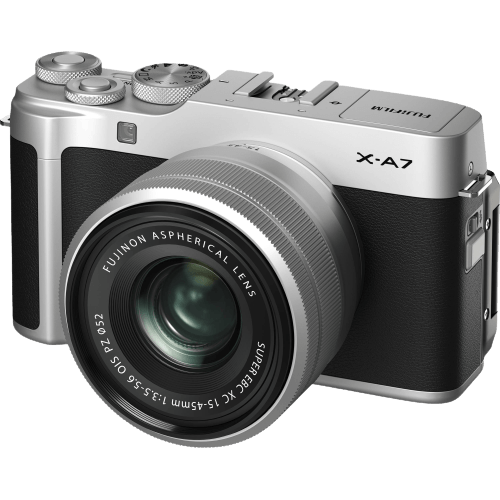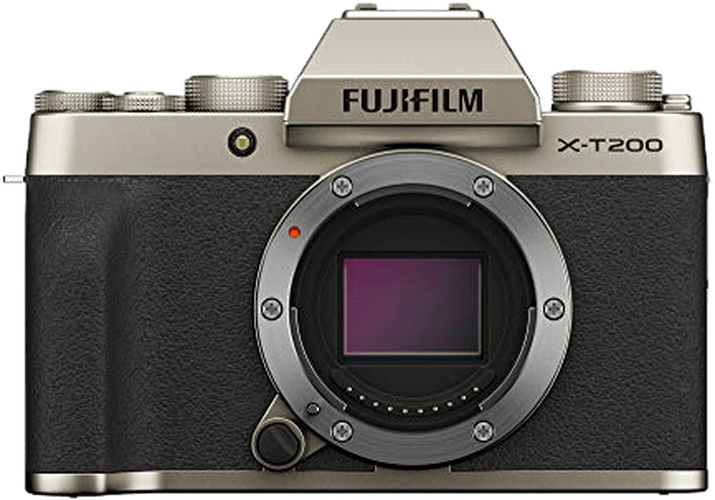Fujifilm X-A7 vs X-T200 Comparison
Fujifilm X-A7

Fujifilm X-T200

The Fujifilm X-T200 edges out the X-A7 with a score of 66/100 compared to 64/100. Both cameras are mirrorless, announced in 2019 and 2020 respectively, and share the same launch price of $699. They have similar dimensions, with the X-T200 being slightly larger and heavier at 121 x 84 x 55mm and 370g, compared to the X-A7’s 119 x 38 x 41mm and 320g.
The X-T200’s higher score reveals its overall superiority, offering better performance and features. However, the X-A7’s smaller size and lighter weight make it more portable and convenient for travel or everyday use. Despite the slight difference in scores, both cameras provide excellent value and quality for their price range, catering to different user preferences and needs.
Fujifilm X-A7 vs X-T200 Overview and Optics
The Fujifilm X-T200 outperforms the Fujifilm X-A7 in optics with a score of 67/100, compared to the X-A7’s 63/100. Both cameras share several specifications, such as a 24-megapixel sensor, 8 frames per second shooting speed, CMOS sensor type, unspecified processor, and Fujifilm X lens mount. Additionally, both cameras have an APS-C sensor size, and neither has a DXOMARK score.
The X-T200 excels in optics primarily due to its image stabilization feature, which the X-A7 lacks. Image stabilization significantly reduces camera shake, resulting in sharper images, particularly in low-light conditions or when using telephoto lenses. Moreover, the X-T200 has a 3:2 aspect ratio, which is more versatile for various photography styles, including landscape and portrait shots.
On the other hand, the X-A7 has a 16:9 aspect ratio, which is more suitable for video recording and widescreen viewing. This aspect ratio could be considered advantageous for those who focus on video content creation. However, this advantage is not enough to outweigh the benefits of image stabilization and a more versatile aspect ratio in the X-T200.
In comparing the optics of these two cameras, the Fujifilm X-T200 is the clear winner, providing image stabilization and a versatile aspect ratio that caters to a wider range of photography styles. While the X-A7 may have a slight edge in video content creation due to its 16:9 aspect ratio, it falls short in providing the stability and adaptability that the X-T200 offers.
Fujifilm X-A7 vs X-T200 Video Performance
The Fujifilm X-T200 outperforms the Fujifilm X-A7 in terms of video capabilities, scoring 91/100 compared to the X-A7’s score of 83/100. Both cameras share some key video features, including a maximum video resolution of 4K and dimensions of 3840 x 2160. Additionally, both models come equipped with built-in time-lapse functionality.
The X-T200’s superior video score is mainly due to its higher maximum video frame rate of 120fps, which is double the X-A7’s frame rate of 60fps. This higher frame rate allows the X-T200 to capture smoother and more detailed slow-motion footage, giving it an edge over the X-A7 in terms of overall video performance.
While the X-A7 does not surpass the X-T200 in any specific video-related aspect, it still holds its own with a respectable video score of 83/100. Its 60fps frame rate remains sufficient for most casual users and provides smooth video playback. The built-in time-lapse functionality is also a shared advantage for both cameras.
Taking these factors into account, the Fujifilm X-T200 is the better choice for users seeking enhanced video capabilities, particularly those interested in capturing slow-motion footage. However, the Fujifilm X-A7 remains a viable option for those who prioritize other features and may not require the additional frame rate offered by the X-T200. Ultimately, the decision between these two cameras should be based on individual preferences and specific video needs.
Fujifilm X-A7 vs X-T200 Features and Benefits
The Fujifilm X-A7 and Fujifilm X-T200 both have a feature score of 74/100, indicating that they share many similarities in terms of features. These cameras have identical screen sizes of 3.5 inches, and their screen resolutions are nearly the same, with the X-A7 having 2,760,000 dots and the X-T200 having 2,780,000 dots. Both cameras also have touchscreens, flip screens, and lack GPS. Additionally, they are both equipped with WIFI and Bluetooth capabilities.
The Fujifilm X-T200 edges out the X-A7 in screen resolution, providing a slightly sharper display for users to view their images and navigate the camera’s settings. This minor difference, however, does not make the X-T200 an overall better camera, as the two cameras share the same feature score.
On the other hand, the Fujifilm X-A7’s features are not significantly better than those of the X-T200. The shared feature score means that both cameras are equally suitable for different users, depending on their individual needs and preferences.
Considering the similarities in features, it is evident that both the Fujifilm X-A7 and the Fujifilm X-T200 are well-matched cameras. The slight difference in screen resolution does not considerably impact the overall performance of either camera. Thus, potential buyers should base their decision on other factors, such as price, design, and personal preferences, rather than solely focusing on the features. Both cameras offer a strong set of features, making them suitable choices for various photography needs.
Fujifilm X-A7 vs X-T200 Storage and Battery
The Fujifilm X-A7 and X-T200 both score 29/100 in storage and battery, indicating identical performance in this aspect. They share the same specifications, with one memory card slot each, accepting SD, SDHC, and SDXC (UHS-I compatible) cards. Both cameras offer 270 shots per charge with the NP-W126S battery type and support USB charging.
Neither camera outperforms the other in storage and battery, as their specifications are equal. Consequently, there is no advantage for either camera in this category. Both cameras provide users with adequate storage options and similar battery life.
In the context of storage and battery, the Fujifilm X-A7 and X-T200 are evenly matched. Therefore, potential buyers should consider other factors, such as general specifications, optics, video, and features, to determine which camera best suits their needs.
Fujifilm X-A7 vs X-T200 – Our Verdict
Are you still undecided about which camera is right for you? Have a look at these popular comparisons that feature the Fujifilm X-A7 or the Fujifilm X-T200:

